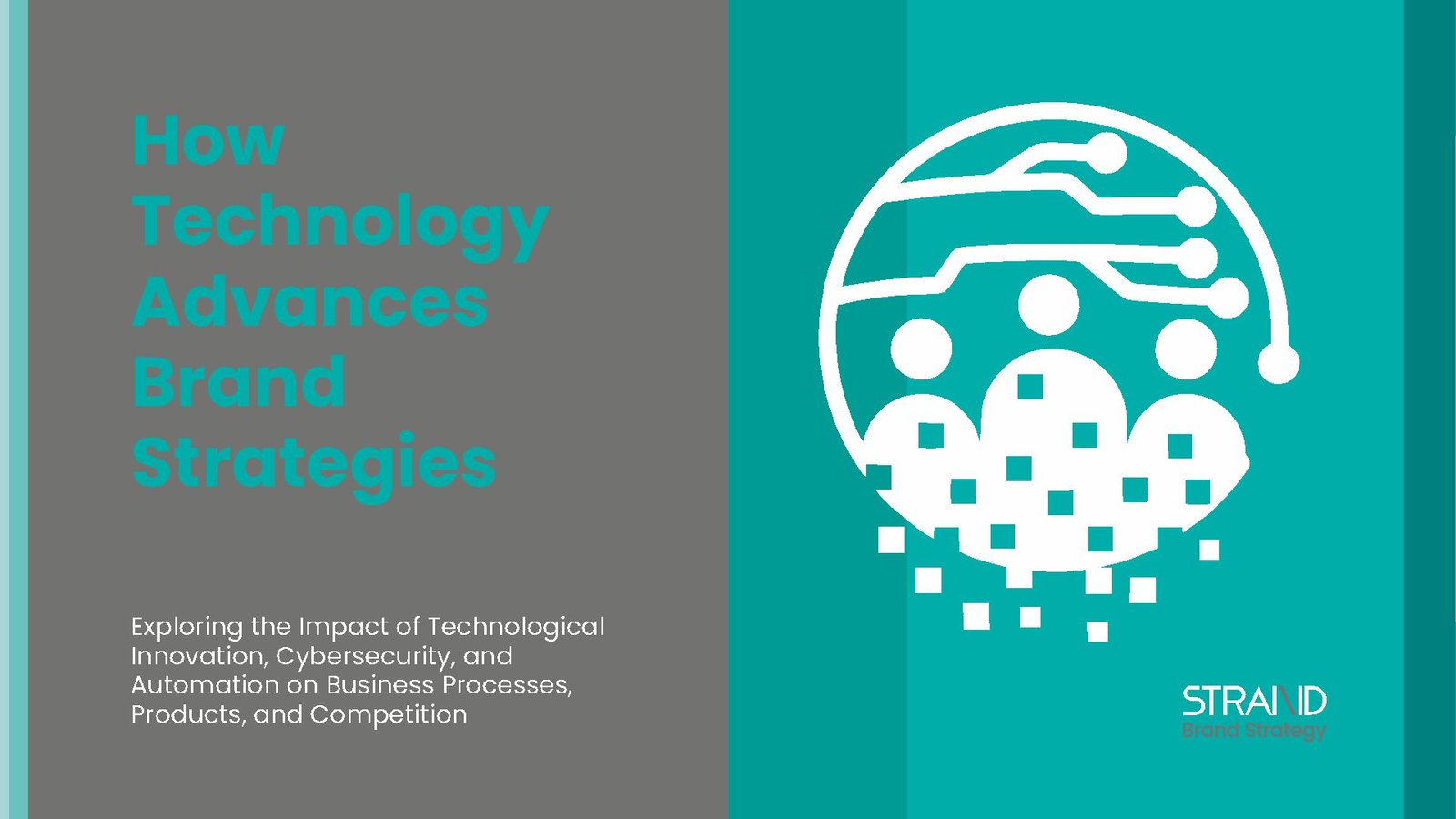How Technology Advances Brand Strategies
8 minutes | 22 Oct 2024Exploring the Impact of Technological Innovation, Cybersecurity, and Automation on Business Processes, Products, and Competition
In today’s fast-paced business environment, technology plays a central role in shaping strategy, product development, and operational efficiency. From digitalization to automation and cybersecurity, technological advancements are fundamentally transforming the way businesses operate and compete. Organizations that embrace these changes are better positioned to thrive in a highly competitive global market, while those that fail to adapt risk falling behind.
This article explores how key technological factors—such as innovation, digitalization, cybersecurity, and automation—affect business processes, product offerings, and competitive dynamics. By understanding and leveraging these advancements, businesses can improve efficiency, enhance customer experiences, and create sustainable competitive advantages.
The Role of Innovation and Digitalization in Business Strategy
Innovation refers to the introduction of new ideas, products, or processes that improve efficiency or create new opportunities. Digitalization, a key component of innovation, involves integrating digital technologies into all aspects of business operations, from communication and marketing to product development and supply chain management.
The digital transformation is sweeping across industries, enabling businesses to streamline operations, enhance customer experiences, and unlock new revenue streams. Companies like Amazon, Netflix, and Uber have revolutionized their industries through digital platforms that connect consumers to services with unprecedented convenience. Similarly, the rise of artificial intelligence (AI), machine learning, and big data analytics is empowering businesses to make more informed decisions, personalize customer experiences, and optimize operations in real-time.
Cloud computing, another major trend, allows businesses to scale operations efficiently, reduce IT costs, and enable remote work. The COVID-19 pandemic accelerated the adoption of digital tools, with businesses of all sizes relying on video conferencing, collaboration platforms, and e-commerce solutions to maintain operations and serve customers.
Digitalization fundamentally changes how businesses interact with customers and deliver value. E-commerce platforms, for example, allow companies to reach global audiences, while AI-driven analytics can improve customer segmentation and product recommendations. This not only enhances customer satisfaction but also drives sales and revenue growth.
Moreover, innovation and digitalization provide new opportunities for startups and small businesses to compete with established players. By leveraging digital tools and platforms, companies can achieve rapid growth without the need for extensive physical infrastructure.
However, digital transformation also poses challenges. Businesses must ensure they have the necessary talent, technology infrastructure, and cybersecurity measures in place to fully capitalize on the benefits of digitalization.
Netflix’s digital transformation is a prime example of innovation reshaping an entire industry. The company moved from a DVD rental business to a digital streaming platform, leveraging data analytics to recommend content tailored to individual users. Today, Netflix is not only a streaming giant but also a major producer of original content, disrupting traditional media and entertainment models.
Amazon’s continued innovation in e-commerce, logistics, and cloud computing demonstrates how digitalization can drive business growth. The company’s use of AI and machine learning to optimize supply chain operations and deliver personalized shopping experiences has given Amazon a competitive edge in the global marketplace.
The Impact of Cybersecurity on Business Strategy
As businesses become increasingly digital, the importance of cybersecurity cannot be overstated. Cyber threats, such as data breaches, ransomware attacks, and phishing scams, have grown in both scale and sophistication. In response, businesses must prioritize the protection of sensitive data, intellectual property, and customer information to maintain trust and avoid costly disruptions.
- Increased Data Vulnerabilities:
The shift toward digital operations has created new vulnerabilities. Cloud-based systems, while offering flexibility and scalability, can be targeted by cyberattacks if not properly secured. The proliferation of IoT (Internet of Things) devices also introduces risks, as each connected device becomes a potential entry point for hackers. - Regulatory Compliance:
Governments around the world are tightening regulations on data privacy and security. The European Union’s General Data Protection Regulation (GDPR) and the California Consumer Privacy Act (CCPA) are just two examples of laws that impose strict requirements on how businesses collect, store, and use personal data. Non-compliance can result in hefty fines, legal action, and reputational damage. - Public Trust:
Consumers are increasingly concerned about how businesses handle their personal data. Companies that fail to implement robust cybersecurity measures risk losing customer trust and loyalty. A data breach can severely harm a brand’s reputation, leading to lost sales, legal liabilities, and long-term damage to the company’s market position.
Cybersecurity presents both challenges and opportunities for businesses. While cyberattacks can be devastating, organizations that prioritize cybersecurity can gain a competitive advantage by building trust with their customers. Furthermore, investing in cybersecurity can prevent costly disruptions to business operations, such as downtime caused by ransomware attacks.
However, the evolving nature of cyber threats means that businesses must continuously update their security measures and stay ahead of emerging risks. This requires not only technical solutions but also a strong organizational culture of security awareness, with employees trained to recognize and respond to potential threats.
Cybersecurity affects multiple stakeholders, including customers, employees, shareholders, and regulators. A breach can lead to financial losses, legal liabilities, and loss of customer confidence. In some cases, businesses may face regulatory fines or lawsuits due to inadequate data protection measures.
Additionally, businesses are increasingly being held accountable for the cybersecurity practices of their supply chains. A weak link in the supply chain can expose the entire business to risks, making third-party risk management a critical component of cybersecurity strategy.
In 2017, Equifax, one of the largest credit reporting agencies in the United States, experienced a massive data breach that exposed the personal information of approximately 147 million people. The breach resulted in significant financial losses, a decline in consumer trust, and regulatory scrutiny. Equifax’s failure to implement adequate security measures underscored the importance of prioritizing cybersecurity.
In contrast, companies like Microsoft have invested heavily in cybersecurity, offering secure cloud solutions and regularly updating their platforms to address vulnerabilities. Microsoft’s proactive approach to cybersecurity has helped the company maintain trust and grow its customer base, particularly among businesses seeking secure cloud services.
The Role of Automation and Artificial Intelligence in Business Strategy
Automation and AI are revolutionizing industries by improving efficiency, reducing costs, and enabling innovation. These technologies are being applied across various sectors, from manufacturing and logistics to healthcare and customer service.
- Automation in Business Processes:
Automation involves the use of technology to perform tasks with minimal human intervention. In manufacturing, robotics and automated assembly lines are increasing productivity and reducing errors. In the service sector, chatbots and automated customer support systems are improving response times and reducing operational costs.
Automation also plays a critical role in supply chain management. Technologies like robotic process automation (RPA) can streamline processes such as inventory management, order fulfillment, and shipping, leading to greater efficiency and cost savings. - AI and Machine Learning for Data Analysis:
AI and machine learning (ML) are enabling businesses to analyze vast amounts of data, uncover patterns, and make data-driven decisions. AI algorithms can predict customer behavior, optimize marketing campaigns, and even detect fraud in real-time. Machine learning models can be used to personalize product recommendations, improving customer satisfaction and loyalty.
In finance, AI-driven trading algorithms can analyze market trends and execute trades faster than any human, leading to increased profitability. Similarly, AI is being used in healthcare to improve diagnostics, predict disease outbreaks, and personalize treatment plans.
While automation and AI offer numerous benefits, they also raise ethical questions and challenges. For instance, automation has the potential to displace workers, particularly in industries that rely heavily on manual labor. As businesses automate more tasks, they must consider the impact on employees and find ways to reskill or redeploy workers.
AI also raises concerns about privacy, bias, and decision-making transparency. AI algorithms rely on data for training; if the data is biased, the system will likely generate biased results. Companies must ensure that their AI systems are fair, transparent, and accountable.
Amazon’s use of AI in its supply chain is a well-known example of how automation can drive efficiency. The company’s fulfillment centers use AI-driven robots to move inventory and optimize the packing and shipping process. This has allowed Amazon to scale operations and deliver products faster than competitors.
In the healthcare sector, IBM’s Watson AI system is being used to analyze medical data and assist in diagnosing diseases. Watson aids cancer diagnosis by analyzing extensive medical literature and recommending personalized treatment options for individual patients.
Embracing Technology for Long-Term Success
In conclusion, technological advancements such as innovation, digitalization, cybersecurity, and automation are fundamentally reshaping the business landscape. Companies that leverage these technologies can streamline operations, improve customer experiences, and create sustainable competitive advantages. However, businesses must also be mindful of the challenges and ethical considerations that accompany these advancements, particularly in areas such as data privacy, cybersecurity, and workforce displacement.
By embracing technological change, businesses can position themselves for long-term success in an increasingly competitive and digital world. The future belongs to companies that strategically adopt technology to drive growth, boost efficiency, and foster innovation successfully. Connect with us and make your Brand win!

